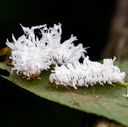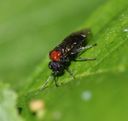Eriocampini
Eriocampini
Classification
- Phylum: Arthropoda
- Subphylum: Hexapoda
- Class: Insecta
- Order: Hymenoptera
- Family: Tenthredinidae
- Subfamily: Allantinae
- Tribe: Eriocampini
Pronunciation
How to pronounce Eriocampini: //ˌɛɹi.oʊˈkæmpɪnaɪ//
These audio files are automatically generated. While they are not always 100% accurate, they are a good starting point.
Images






Summary
The tribe Eriocampini consists of various sawfly species, primarily within the genus Eriocampa, which thrive in specific wooded habitats and have significant ecological roles as herbivores.
Physical Characteristics
Sawflies in the genus Eriocampa typically have robust bodies and are characterized by their distinct saw-like ovipositors which females use to cut into plant tissues. They exhibit various color patterns, often resembling the plants they inhabit.
Identification Tips
Identification can be made based on morphological features such as body shape, size, and the structure of the ovipositor. Each species can also be identified by specific markings and coloration.
Habitat
Eriocampa species are commonly found in wooded or shrubby areas where their host plants, such as alder and walnut, grow. They often inhabit environments with moist conditions due to the association with their host plants.
Distribution
Eriocampini is present in various regions, with Eriocampa species prevalent in North America, particularly in areas where their host trees are located.
Diet
The larvae of Eriocampa species are known to primarily feed on the leaves of their host plants, including various species of alder and walnut.
Life Cycle
Eriocampa undergoes complete metamorphosis with distinct egg, larval, pupal, and adult stages. Larvae often feed on foliage before pupating in the soil or among debris.
Reproduction
Reproduction occurs via oviposition, where females lay eggs in the plant tissue. The larvae hatch and begin their herbivorous lifestyle, leading to further growth through several instars before pupation.
Predators
Predators of Eriocampini include various species of birds, parasitic wasps, and other insects that prey on larvae and adults.
Ecosystem Role
Eriocampa species play an essential role in their ecosystems by acting as herbivores, which can influence plant community dynamics, as well as serving as prey for various predators.
Economic Impact
Certain Eriocampa species may have impacts on forestry and agriculture, particularly those oriented towards the crops they infest, such as walnut.
Collecting Methods
- Net collection during active adult periods
- Light traps to attract and collect nocturnal species
Preservation Methods
- Pinning specimens for entomological collections
- Drying specimens for storage
Evolution
The Eriocampini tribe is part of the family Tenthredinidae, which has evolved various forms and behaviors conducive to herbivory and adaptation to different ecosystems.
Similar Taxa
- Tenthredinidae
- Allantinae
- Megalodontes
Misconceptions
Eriocampa species are sometimes confused with other similar sawfly genera, leading to misidentification, particularly by those unfamiliar with the differences in their ovipositors and larval stages.
Tags
- Eriocampini
- sawflies
- Hymenoptera
- Eriocampa